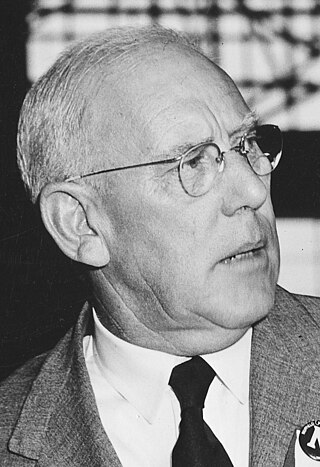Related Research Articles

John Thomas Lang, nicknamed "The Big Fella", was an Australian politician. He served two terms as premier of New South Wales, in office from 1925 to 1927 and from 1930 to 1932. He was the state leader of the Australian Labor Party (ALP) from 1923 to 1939 and his Lang Labor faction was an influential force in both state and federal politics, breaking away from the official ALP on several occasions.

The Division of Reid is an Australian electoral division in the state of New South Wales.

Lang Labor was a faction of the Australian Labor Party (ALP) consisting of the supporters of Jack Lang, who served two terms as Premier of New South Wales and was the party's state leader from 1923 to 1939. It controlled the New South Wales branch of the ALP throughout most of the 1920s and 1930s. The faction broke away to form separate parliamentary parties on several occasions and stood competing candidates against the ALP in state and federal elections.

Auburn is an electoral district of the Legislative Assembly of the Australian state of New South Wales in Sydney's West. It is currently represented by Lynda Voltz, after the 2019 election.
The Australian Labor Party (Non-Communist), which operated from 1940 to 1941, was a breakaway from the Australian Labor Party (ALP), and was associated with the Lang Labor faction and former New South Wales premier Jack Lang.
Members of the New South Wales Legislative Assembly who served in the 33rd parliament held their seats from 1941 to 1944. They were elected at the 1941 state election, and at by-elections. During this term, the opposition United Australia Party merged with the new Commonwealth Party to form the Democratic Party in late 1943. The merger was only at a state level, however; the federal United Australia Party, however, remained intact during this period. The Speaker was Daniel Clyne.
Members of the New South Wales Legislative Assembly who served in the 34th parliament held their seats from 1944 to 1947. They were elected at the 1944 state election, and at by-elections. The opposition Democratic Party merged into the nascent Liberal Party in late 1944, becoming the New South Wales branch of the new party. The Speaker was Daniel Clyne.
Members of the New South Wales Legislative Assembly who served in the 32nd parliament held their seats from 1938 to 1941. They were elected at the 1938 state election, and at by-elections. The Speaker was Reginald Weaver.
Members of the New South Wales Legislative Assembly who served in the 27th parliament of New South Wales held their seats from 1925 to 1927. They were elected at the 1925 state election on 30 May 1925. The Speaker was James Dooley.
James Christian Lang, usually known as Chris Lang, was an Australian politician. The son of Jack Lang, Premier of New South Wales 1925–27 and 1930–32, he succeeded his father as the member for Auburn in the New South Wales Legislative Assembly, serving from 1946 to 1950.

The 1941 New South Wales state election was held on 10 May 1941. This election was for all of the 90 seats in the 33rd New South Wales Legislative Assembly and was conducted in single-member constituencies with compulsory preferential voting.

The 1950 New South Wales state election was held on 17 June 1950. It was conducted in single member constituencies with compulsory preferential voting and was held on boundaries created at a 1949 redistribution. The election was for all of the 94 seats in the Legislative Assembly, which was an increase of 4 seats since the previous election.
Thomas Vernon Ryan was an Australian politician. He was a Labor Party member of the New South Wales Legislative Assembly from 1956 to 1965, representing the electorate of Auburn.
Joseph Patrick Byrne was an Australian politician. He was a Labor Party member of the New South Wales Legislative Assembly from 1930 to 1932, representing the electorate of Parramatta.

The 1944 New South Wales state election was held on 27 May 1944. It was conducted in single member constituencies with compulsory preferential voting and was held on boundaries created at a 1940 redistribution. The election was for all of the 90 seats in the Legislative Assembly.
Annandale, an electoral district of the Legislative Assembly in the Australian state of New South Wales, had two incarnations, the first from 1894 to 1920, the second from 1927 to 1950.
Auburn, an electoral district of the Legislative Assembly in the Australian state of New South Wales, was established in 1927.
The Federal Labor Party were the members of the Australian Labor Party in the state of New South Wales who supported the federal party leadership in the split with the state Labor party which broke away in 1931. Federal Labor retained some seats in the Parliament of Australia but was a minor party in state elections. The dispute was healed in 1936.
Darling Harbour, an electoral district of the Legislative Assembly in the Australian state of New South Wales was created in 1904 and abolished in 1913.
A by-election was held for the New South Wales Legislative Assembly electorate of Auburn on 9 November 1946 following the resignation of Jack Lang to successfully contest the seat of Reid at the 1946 federal election. His son, Chris Lang, won the by-election for his father's old seat.
References
- ↑ "The Hon. John Thomas Lang (1876-1975)". Former members of the Parliament of New South Wales . Retrieved 30 April 2019.
- 1 2 Green, Antony. "1943 Auburn by-election". New South Wales Election Results 1856-2007. Parliament of New South Wales . Retrieved 27 August 2019.